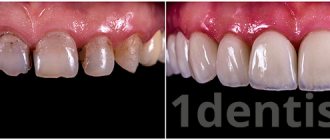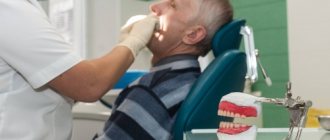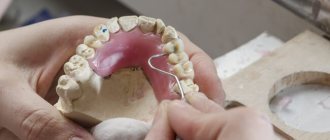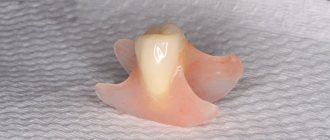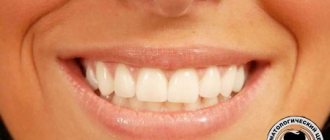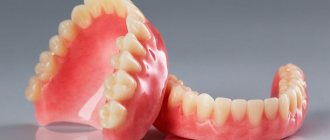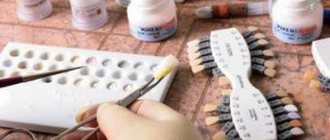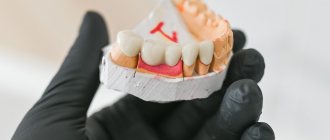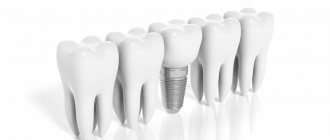- home
- What is important to know?
Conventional standard prosthetics require grinding of the corresponding tooth, as well as neighboring ones. This procedure is carried out so that it is more convenient to install the prosthesis and nothing interferes with the process. This method has a significant disadvantage, which is that it leads to tooth decay and loss. This is how a new, more gentle method for installing a prosthesis emerged. It is called contactless. Its essence is that it allows you to restore the normal functioning of the jaw without grinding, painlessly and without serious consequences.
Dental prosthetics without grinding, what is it?
Before analyzing the pros and cons of this procedure and types of prosthetics, you need to understand the definition itself. So, prosthetics without turning is one of the methods of prosthetics that do not destroy the tooth structure.
To install a crown, you must first suppress the caries so that it does not develop further. To do this, the canals are cleaned, the tooth is treated with a drill, thus preparing the cavity for further actions. When installing a bridge, healthy adjacent teeth are also affected. They also have to be depulped, that is, the nerves have to be removed.
During prosthetics, crowns are placed on healthy supporting teeth on both sides of the void in the gum. In order to install crowns and fix them, you need to grind down the healthy tooth covering. This is a big disadvantage of this procedure. It is unpleasant and, to some extent, offensive, because orthopedic dentists themselves grind down healthy, strong teeth.
To summarize, we can say that by treating one tooth, we kill the neighboring ones, bringing them closer to possible destruction, since they are considered dead. And they are destroyed due to the fact that they cease to participate in the exchange of useful substances and become more vulnerable. The situation is aggravated by the increased load due to the fact that they are a support for the prosthesis.
Despite these consequences, prosthetics using the methods described above are still used in dentistry, but the method without grinding is becoming increasingly popular.
Indications for removal along with the root
No dentist will remove a tooth just like that, since each one is important for the normal functioning of the dental system - doctors still try to preserve them. To do this, fillings or restorative inlays, crowns, pins and stump inlays are placed in the root canals. So is it necessary to remove tooth roots before getting dentures? Yes, indeed, sometimes situations arise that removal is the only option, otherwise complications are possible - up to infection of the jaw bone or loss of all units in a row.
Let's consider cases when deletion is indispensable:
- the presence of vertical cracks in the roots,
- irreparable perforations in the root wall or in the bifurcation area (the place where the roots begin to branch under the crown),
- presence of a piece of dental instrument in the root canal that cannot be removed,
- chipping of the crown deep under the gum: in this case, placing a filling or core inlay may be problematic due to the damp environment around - such a restoration will not last long,
- the presence of neoplasms under the roots (cysts, granulomas) that cannot be eliminated without removal,
- destruction or complete dislocation due to injury: blow, bruise, gnawing something hard,
- inability to go through root canals with an instrument due to their non-standard shape,
- osteomyelitis of the jaw: if osteotomy (cutting off) of pathological areas of the bone is required,
- severe loss of bone and gums against the background of the late stages of periodontitis and periodontal disease: here the teeth become very mobile, and tartar builds up along the roots - an infectious focus arises, which leads to inflammation and toxic damage to the surrounding tissues (gums and jaw bone).
Types of dental prosthetics without turning.
All available types are aimed at solving the problem of missing one or more teeth. All types have the main difference - the durability of the result.
The most practical and reliable method is implantation. This attitude remains for life. This is its undeniable advantage for many.
How are implants installed?
In this procedure, an artificial root is inserted into the cavity where the tooth used to be. After this, an artificial crown is installed on it. As a result, it turns out that the one made will not be externally different from its own. The only difference is that it is attached to an artificial root and is not considered living, since there are no nerves there. Implants can replace more than one tooth, but even several neighboring ones, and the prosthesis can support a “bridge.”
The procedure discussed above is the most reliable method of installing a prosthesis. But the downside of this is that many people have contraindications from their doctor.
As mentioned above, this is not the only type of prosthetics, but it is the one that is lifelong. All the rest are rather temporary installations.
Adhesive method without turning.
This method is otherwise called the Maryland bridge. In simple terms, this is the installation of a bridge without the turning procedure. This method refers to complete dental prosthetics. If a tooth is completely missing, then small holes are made on two adjacent ones, after which an almost invisible tape is installed to serve as a support for the tooth being restored.
The steps to create a new tooth are carried out in one session. That is, in one visit to the doctor, he, using translucent tape and a fiberglass pin, forms the foundation for attaching the prosthesis to previously processed and prepared areas of healthy teeth.
A “Maryland bridge” can be used to replace no more than one tooth located between two healthy ones, and if several in a row are damaged, then the AMP cannot be used. This is due to the fact that such a prosthesis is made of a rather fragile material that cannot withstand heavy loads. Pressure occurs in any case when chewing; you don’t even need to make any special efforts for this. If only one tooth is lost, then you can restore it without any problems using this method, and if more than one, then it is better not to risk it and use other installations discussed in the article.
Elimination of defects in the dentition requires compliance with oral hygiene.
Prosthetics of anterior and chewing teeth without turning
An indisputable fact is that implantation is the safest, proven method for the lifelong installation of a tooth in the place of a lost one. This is due to the fact that the procedure in question does not damage adjacent dental units.
The procedure involves installing a titanium body into the jaw, and later replacing it with a crown. The technique is mainly based on osseointegration, which means that dental implants completely merge into one with the jawbone and thus completely and completely replace the lost living tooth both in aesthetics and functionality, which is very important. The process is not long, it takes no more than 40-45 minutes and is carried out under local anesthesia. During the operation, the person does not feel pain or discomfort. After it, there is also no discomfort, but only the client’s pleasant surprise at the result he saw.
As already mentioned, implants can last a lifetime, as they fuse tightly with the jaw bone. There is an example where the first patient lived with implants for about 50 years.
Bridge without turning
This type is a relatively new method for restoring a lost tooth. It's relatively uncomplicated. It consists in creating microchannels on the sides of the so-called abutment teeth, where locks are installed and fixed in order to hold the intermediate part of the bridge. At the same time, nerves are not removed from adjacent supporting dental units and their surfaces are not ground down. Bridge-like prosthetic structures are quite strong and therefore withstand loads even under heavy loads and pressure during chewing. The locks evenly distribute the load, which eliminates strong pressure and injury to the gums.
Despite the described advantages, many dentists still recommend the installation as a temporary one, explaining that it is not 100% reliable. It is recommended to resort to this method during the period when the installed implant takes root in the area visible when smiling.
Adhesive technique for restoring teeth without grinding adjacent teeth
This method involves fixing the prosthesis using elastic and durable materials, such as fiberglass or plastic. Adhesive bridges are divided into three groups based on different types of fastening.
- Fastening using glue. This technique is considered quite safe and reversible if the client refuses the prosthesis in the future.
- Methods involving the treatment of adjacent teeth. It also does not cause significant harm because it is much safer than turning. To secure the fiberglass tape, the orthodontist makes small indentations on the supporting teeth, either on top or behind.
Adhesive structures are not reliable, as a result of which they are used only for a short period of time, and also for repairing no more than one tooth. Despite its unreliability, this method is quite popular and widespread. It is inexpensive, the price range is around 3,000 rubles.
Removable prosthetics without turning
The fastest and most inexpensive type of removable prosthesis installation is a nylon prosthesis. What it is? This is a structure that consists of an artificial row of teeth and a frame that holds them together. Thanks to the bending properties of nylon, the prosthesis easily envelops the teeth and gums, being fixed by the lower or upper palate. The advantages include the fact that such a prosthesis can replace one or two teeth, or an entire row. Speaking about the disadvantages, the following can be noted:
- Flexibility and elasticity have negative consequences in the form of rubbing and necrosis of the areas where the prosthesis is attached.
- Since the relief of the oral cavity changes over the years, this installation has to be changed or adjusted. This is also caused by wear and tear of the material.
- It is not very comfortable to walk with nylon prostheses. Moreover, they must be regularly removed, cleaned, processed and reinstalled, which takes quite a lot of time.
Orthopedic stage
Final stage. Fixation of a crown or fixed prosthesis (on 4 or 6 implants). The method of fixation depends entirely on the chosen design. For example, the prosthesis is attached to screws, which are screwed through special holes and then masked.
| Is it painful to get a dental implant? No. All work, starting with bone grafting, is performed under local anesthesia, the composition of which is selected individually. Our patients feel as comfortable as possible. |
At the “Dr. Fedorov Implantation Center,” the doctor, even at the preparatory stage, tells the patient how dental implants are placed and informs about the features of the upcoming operation. The first consultation with an implant surgeon is free.
Are there any restrictions for dental prosthetics without grinding?
Like many other orthodontic procedures, this one has its limitations and contraindications. These include:
- Presence of cancer.
- Mental disorders.
- Problems with the cardiovascular system.
- Blood diseases (poor clotting).
- Physical exhaustion, weakness due to recent illnesses and attacks.
- Presence of sources of infection in the oral cavity.
- Inflammation in the gums.
- An allergic reaction to the material from which the prosthesis is made.
These are the main points that should be taken into account when installing prostheses without contact.
So, the types of prosthetics, contraindications have already been described above, and the advantages and disadvantages of non-contact installation of a prosthesis have been indirectly mentioned.
Requirements for the surviving part
Unfortunately, fixing the prosthesis to the tooth root is not always possible. To do this, the latter must satisfy a number of requirements:
- have strong walls and be long enough;
- not be affected by caries;
- be well passable (otherwise it will not be possible to seal it);
- have walls of the required thickness to hold the inserted pin and withstand the pressure exerted during chewing food;
- do not have inflammatory changes in the upper part.
If the root is very curved, it is very small in size, it will not be possible to use it during prosthetics. The situation is similar if there are fistulas in the gums that do not go away even after filling.
What are the advantages of dental prosthetics without grinding?
- No discomfort or pain during the procedure.
- No destructive load on soft tissues in the oral cavity.
- A chance to create a beautiful smile without the suspicion of others about dentures.
- Possibility to replace the prosthesis in a short time.
- Uniform and gentle distribution of load on the gums.
- No difficulties in preparing for the procedure. It is enough to maintain hygiene.
- Repeating the prosthetic procedure cannot be ruled out.
Non-surgical installation of implants
If the patient chooses implantation with immediate loading, he saves himself from surgical intervention, which occurs in several situations:
- When it is necessary to adjust the volume of bone tissue. In such a situation, dental implants have a distinctive feature - they can be installed even where there is a small amount of bone tissue. The shape and thread of the dental elements allow for painless installation. There is no need to build up bone tissue with this method of tooth restoration. To fix the dental element, the bone shell of the jaw is used, as well as the basal layer. Neither the tunica nor the basal layer will be reduced even in situations of severe atrophy. They will remain just as strong and firmly fix the implant.
- When it is necessary to implant a dental element into bone tissue. If conventional implants are used, then a rather complex operation must be performed. It is necessary to cut and peel off the gum, then drill a hole of a certain size in the bone and then install the dental element. After the structure is fixed, the gum is sutured. After the implant has healed, the gum is cut again and a crown is installed. When using one-piece dental structures, such moments can be avoided. No incision is made, just a puncture is made, into which the dental product is subsequently screwed into the bone tissue. The risk of injury is reduced to a minimum.
Thus, we can conclude that non-surgical implantation exists. Such operations are carried out using immediate loading. The method serves as express prosthetics. After the implant is installed, impressions of the tooth are taken to create permanent dentures. They are installed after two or three days.
With this method of restoring teeth, the load on the teeth will be distributed evenly, this is a feature of the technology. Bone cells will evenly receive the necessary nutrients for growth. The tissue regenerates quite quickly, which leads to the natural functioning of the oral cavity.
Disadvantages and contraindications
In addition to a sufficient number of advantages, there are also disadvantages, which include:
- If the material is fragile or poorly made, then the dentures will not last long. Approximately 4 years.
- Not all prosthetic methods are suitable for replacing chewing rows, which is also due to low strength and wear resistance.
- It should not be used if you have bad habits, malocclusion, or serious diseases, especially infectious ones.
- Noticeable location of fasteners that will be located on the lingual side.

